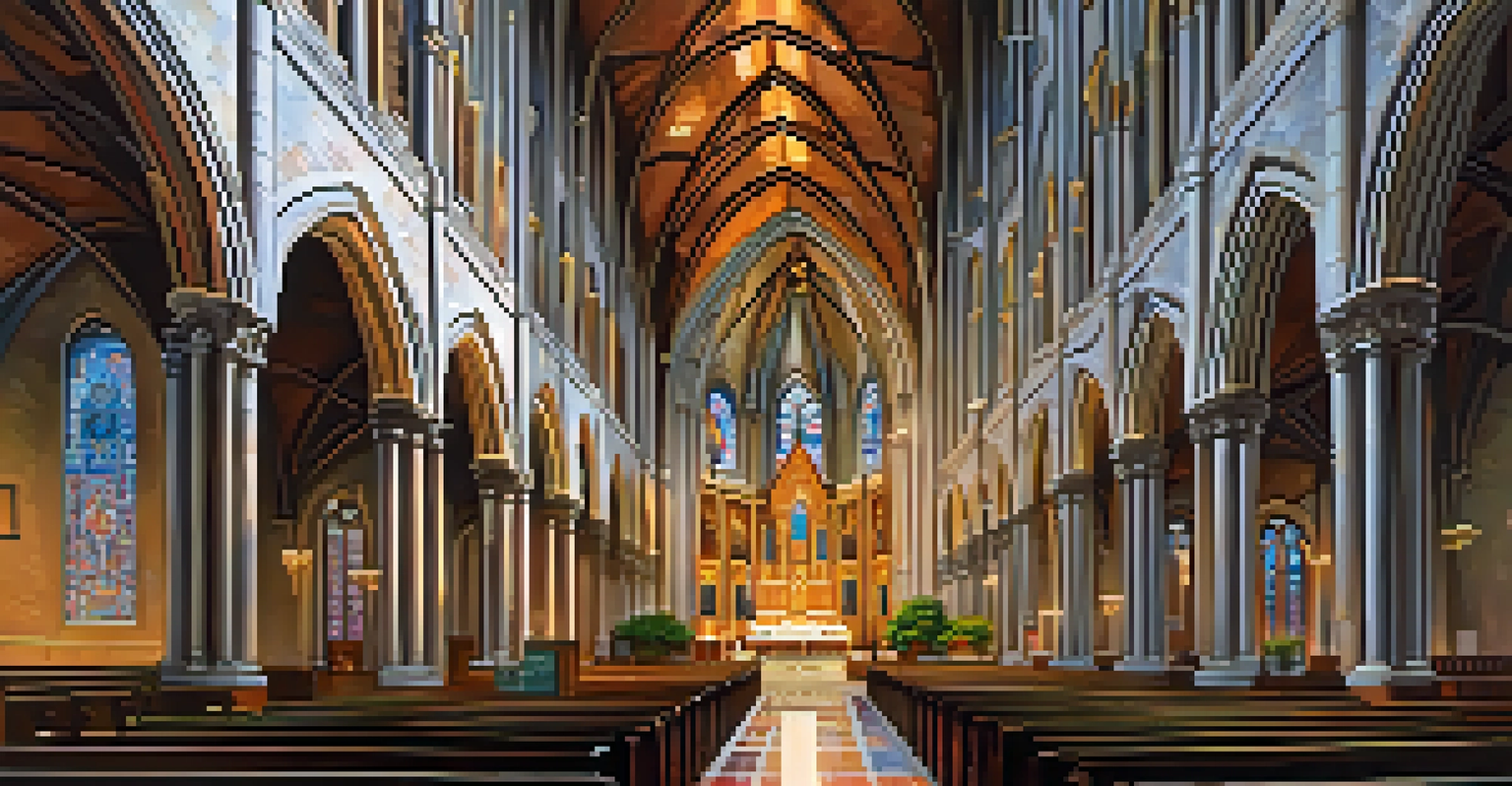Architectural Heritage: Missouri's Historic Landmarks

The Importance of Architectural Heritage in Missouri
Architectural heritage plays a crucial role in understanding a region's history and culture. In Missouri, buildings and structures reflect the unique stories of its communities, showcasing a blend of styles from various eras. From Native American structures to modern designs, these landmarks serve as physical reminders of the past and are essential for preserving local identity.
Preservation of our heritage is not a luxury; it is a necessity for our future.
As visitors explore Missouri, they encounter a rich tapestry of architectural styles including Gothic, Colonial, and Art Deco. Each style tells a different story, influenced by the people, events, and resources of the time. This diversity not only enriches the state’s aesthetic but also enhances its cultural significance.
Preserving Missouri’s architectural heritage is vital for future generations. It helps foster a sense of pride among residents and can stimulate local economies through tourism. By maintaining these historic sites, Missouri not only honors its past but also builds a foundation for its future.
St. Louis: A Hub of Historic Architectural Wonders
St. Louis boasts some of Missouri's most iconic landmarks, showcasing a variety of architectural styles. The Gateway Arch, a modern marvel, symbolizes the westward expansion of the United States, while the historic Old Courthouse reflects the city’s role in pivotal moments of American history. These structures not only highlight the city’s architectural diversity but also its historical significance.

Another gem in St. Louis is the Cathedral Basilica, renowned for its stunning mosaics and Romanesque architecture. This landmark attracts visitors not only for its beauty but also for the sense of peace it embodies. The juxtaposition of such diverse structures illustrates the city's evolution over time.
Preserving Missouri's Heritage
Maintaining architectural heritage fosters community pride and stimulates local economies through tourism.
St. Louis serves as a reminder of the importance of preserving architectural treasures. Through initiatives to restore and maintain these historic sites, the city honors its past while inviting future generations to appreciate its rich heritage.
Kansas City: Blending Tradition and Modernity
Kansas City’s architectural landscape is a vibrant mix of historic and contemporary designs. The Country Club Plaza, inspired by Spanish architecture, stands as a testament to the city’s commitment to creating a unique urban experience. It beautifully blends tradition with modern shopping and dining, making it a popular destination.
Heritage is our legacy from the past, what we live with today, and what we pass on to future generations.
In contrast, the Kauffman Center for the Performing Arts showcases cutting-edge design while serving as a cultural hub. Its sweeping lines and dramatic roof structure symbolize Kansas City’s forward-thinking spirit. This blend of old and new is a reflection of the city’s dynamic character and growth.
Preservation efforts in Kansas City are crucial to maintaining this balance. By recognizing and protecting historic buildings, the city ensures that its rich architectural heritage continues to thrive alongside modern developments.
The Role of Preservation Societies in Missouri
Preservation societies play a vital role in safeguarding Missouri’s architectural heritage. These organizations work tirelessly to advocate for the protection of historic sites, ensuring that future generations can appreciate them. Their efforts include fundraising, education, and community engagement to promote awareness and involvement.
One notable example is the Missouri Alliance for Historic Preservation, which highlights endangered historic sites and encourages community involvement in their preservation. Through various initiatives, they inspire local residents to take pride in their architectural heritage and participate in its protection.
Historic Landmarks in St. Louis
St. Louis features iconic structures like the Gateway Arch and the Cathedral Basilica, showcasing its rich architectural diversity and historical significance.
The collaboration between preservation societies and local governments is essential for effective preservation. By working together, they can create policies and programs that support the maintenance of historic landmarks, fostering a sense of community and continuity.
Exploring Rural Missouri's Historic Architecture
While urban areas like St. Louis and Kansas City are often in the spotlight, rural Missouri also boasts a wealth of historic architecture. Small towns are home to charming structures that reflect the region's agricultural roots and community spirit. These buildings, often lovingly maintained, tell stories of the families and businesses that once thrived there.
Examples include quaint courthouses, old schools, and historic homes that have withstood the test of time. Each structure carries with it a unique narrative of the town’s development and the people who shaped its history. Exploring these rural landmarks provides a glimpse into Missouri’s past, often overlooked in favor of larger cities.
Efforts to promote rural heritage tourism are gaining momentum, inviting visitors to explore these hidden gems. By highlighting the significance of rural architecture, communities can strengthen their identity and boost local economies through tourism.
Landmark Designations: What They Mean for Missouri
Landmark designations, such as those on the National Register of Historic Places, provide critical protection for Missouri’s historic structures. These designations recognize the importance of a building's architectural integrity and historical significance. They help ensure that these sites are preserved for future generations to enjoy and learn from.
Being listed can also have practical benefits, such as eligibility for tax incentives and grants for restoration efforts. This financial support encourages property owners to invest in the upkeep and restoration of historic buildings, helping to maintain their character and charm.
Rural Architecture's Charm
Rural Missouri's historic buildings reflect the region's agricultural roots and community spirit, offering unique narratives often overlooked in urban areas.
Understanding the implications of these designations is important for local communities. It fosters a sense of pride and encourages involvement in preservation efforts, ensuring that the state’s architectural heritage remains a vibrant part of its cultural landscape.
Engaging the Community in Heritage Preservation
Community engagement is key to successful heritage preservation in Missouri. When residents take an active interest in their local history, they contribute to the preservation of their architectural heritage. Programs that involve citizens in restoration projects or educational initiatives can foster a deeper appreciation for local landmarks.
Workshops, guided tours, and community events centered around historic sites help raise awareness and cultivate pride in one’s neighborhood. These activities not only educate residents but also strengthen community bonds by celebrating shared history and culture.

Ultimately, when communities come together to support heritage preservation, they create a lasting impact. This collaborative spirit ensures that Missouri’s historic landmarks continue to be cherished and celebrated for generations to come.
The Future of Architectural Heritage in Missouri
Looking ahead, the future of Missouri’s architectural heritage relies on a balance between preservation and progress. As cities expand and evolve, it’s crucial to integrate modern needs while safeguarding historic sites. This approach requires thoughtful planning and community involvement to ensure that growth does not come at the expense of heritage.
Innovative solutions, such as adaptive reuse, can breathe new life into historic buildings. By repurposing these structures for contemporary uses, communities can maintain their historical character while meeting modern demands. This not only preserves the past but also enhances the vibrancy of local neighborhoods.
Ultimately, the commitment to preserving Missouri’s architectural heritage is a reflection of the state’s values. By cherishing its past and embracing the future, Missouri can continue to serve as a model of how history and progress can coexist harmoniously.